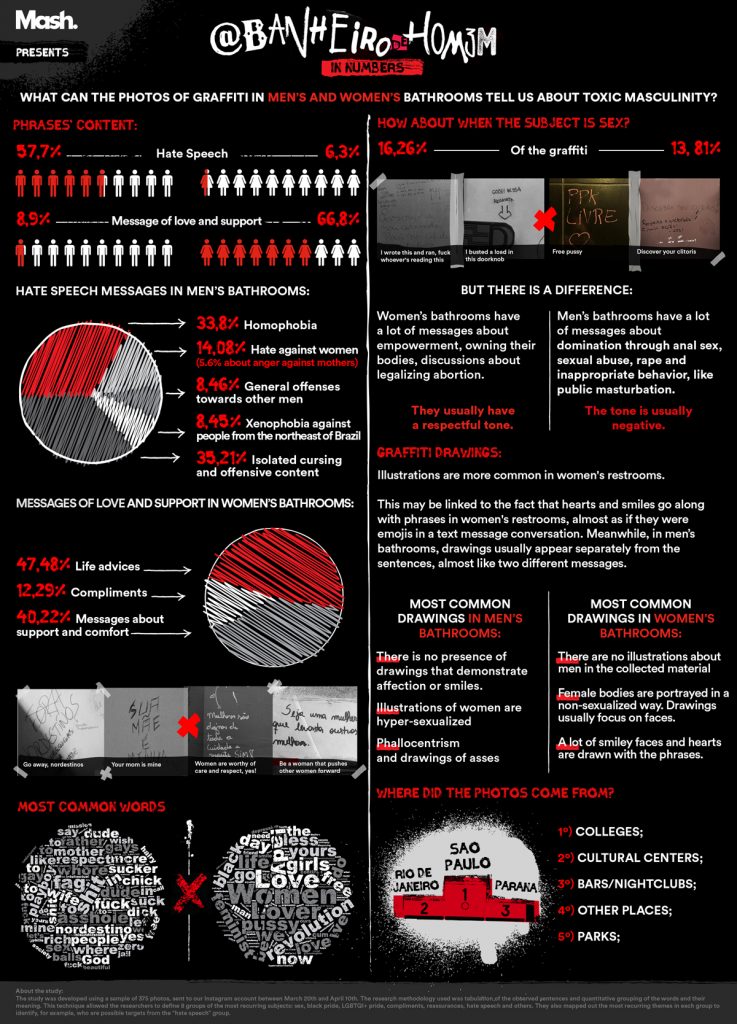
Have you ever stopped to think about what graffiti on men’s and women’s bathrooms can reveal about toxic masculinity? This is exactly what the @banheirodehomem (@mensbathroom) project wanted to find out. The study, in association with agency Soko, compared the content of phrases and expressions found on both restrooms.
However, it’s important to understand where toxic masculinity comes from in the first place, starting from the myths-learned during childhood about what is and what is not a “guy thing”.
The problem is that these preconceptions about men’s attitudes can generate toxic behaviour that harm not only them, who might feel the need to adapt their personality just to fit in, but also hurt those who live with them, since these myths are the root of problems such as sexism and homophobia.
Toxic masculinity teaches that expressing feelings, crying and opening up emotionally are “weaknesses” and traits to be avoided at any cost, because “a man who is a man is always strong.” According to the study, in addition to forcing them to hide their feelings and affection, toxic masculinity makes men think that people who don’t do it are weaker. The representation of this way of thinking is stamped on the walls of the bathrooms, but is also present in our daily lives.
Since the project’s launch, the social media profile @banheirodehomem has been receiving photos of the graffiti in women’s and men’s restrooms from the public.
The first phase of the project also featured the photos of the guest photographers Lucas Pardal and Iasha Salerno. Over the course of two weeks, the collected images were compiled and used as basis for the research.
When the graffiti was analysed, the first impressions showed that, in most cases, they did not have a signature of the person who did it, which means that the purpose of the graffiti on the bathroom was not to identify the author or ask for an answer on what was written, but to communicate a message that can incite a reaction in those who read it.
“We need to reflect on this: why is it that inside female bathrooms almost all the messages are about support whereas, inside male’s, the messages are about hate? To find this answer, we need to take a better look at the toxic masculinity, which teaches men that violence is an important part of being a man, and that emotions, affection and conversations about their problems are not,” said Felipe Simi, Head of Creative Data and CEO at Soko.
While in the men’s toilets 57.7% of the messages were hate speech, in the female’s 66.8% of them were supportive and instructive. When SOKO analysed the content of hate speech in men’s toilets, 33.8% of the graffiti involved homophobia,14% sexism, and 5.6% of this total involves aggression against mothers.
Another interesting fact is related to graffiti about “sex”, which are found in both bathrooms: in the female’s, this is the subject in 13.81% of the messages; in the male’s, in 16.26%. The amount may be close, but the difference between the content is remarkable.
In the female bathrooms, the messages are about the importance of women being the owner of their own body, empowerment and discussions about the legalisation of abortion in Brazil. On the other hand, on the men’s bathrooms, they talk about domination through anal and oral sex, sexual abuse, rape and inappropriate behaviour, like masturbating in public places.
The results of the social essay can be found on their Instagram page. With the support of Mash, an underwear brand that has shown through its positioning the importance to rethink the way society sees masculinity and the need to deconstruct these stereotypes, the project aims not only to expose the differences between what is found in men’s and women’s bathrooms, but to generate a conversation about this theme.
This is a really serious topic as 75% of men, aged between 24 and 44 years old, have never heard of toxic masculinity, according to Google Consumer Surveys (April 2018).
The project was created and produced by the agency Soko, that was also responsible for repositioning the brand in the market in 2018.
Source: Soko


You must be logged in to post a comment Login